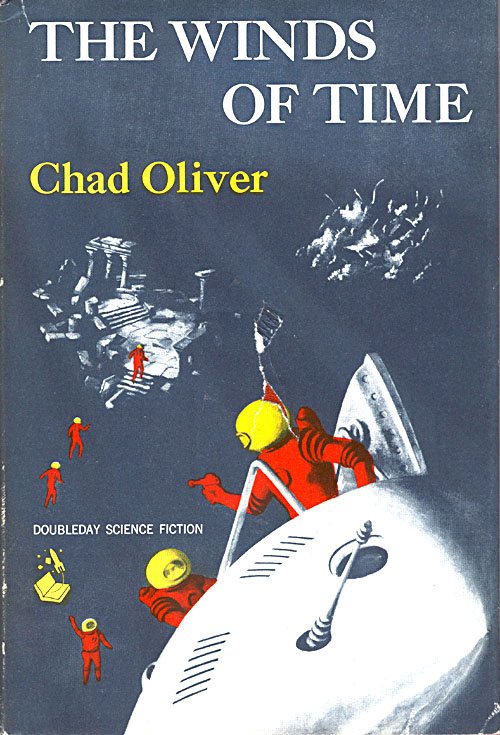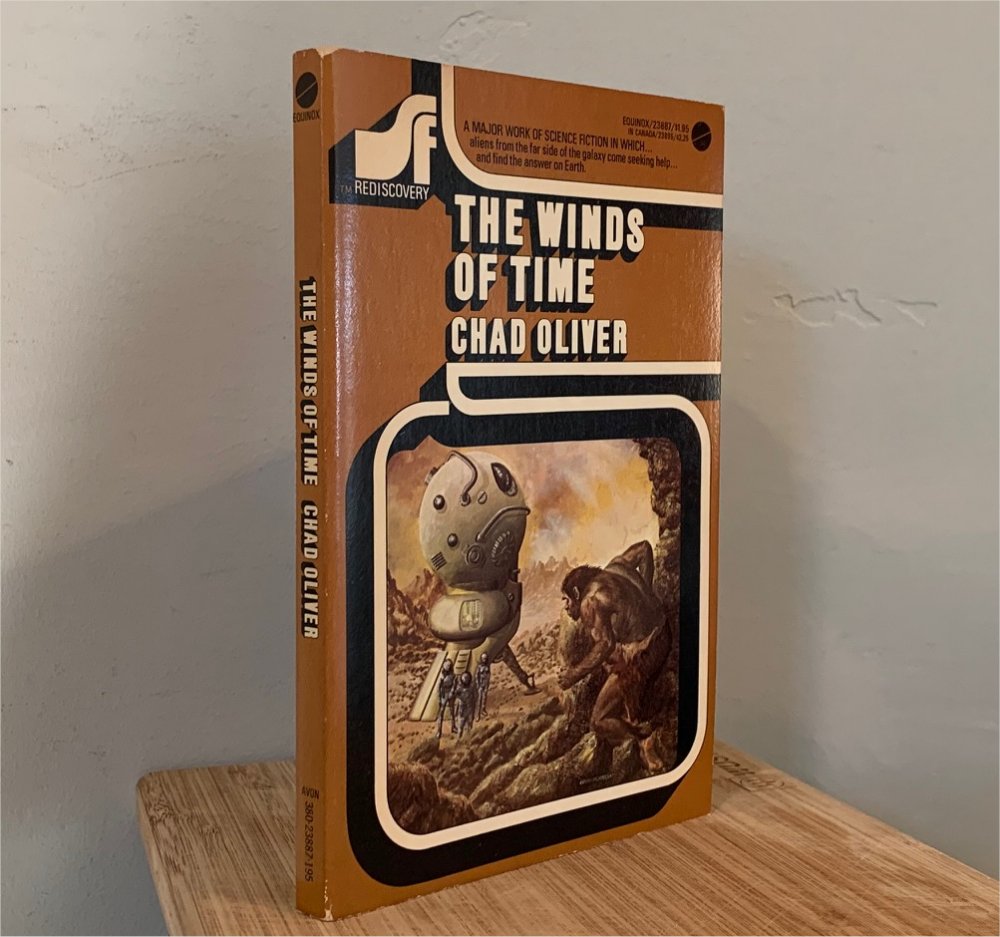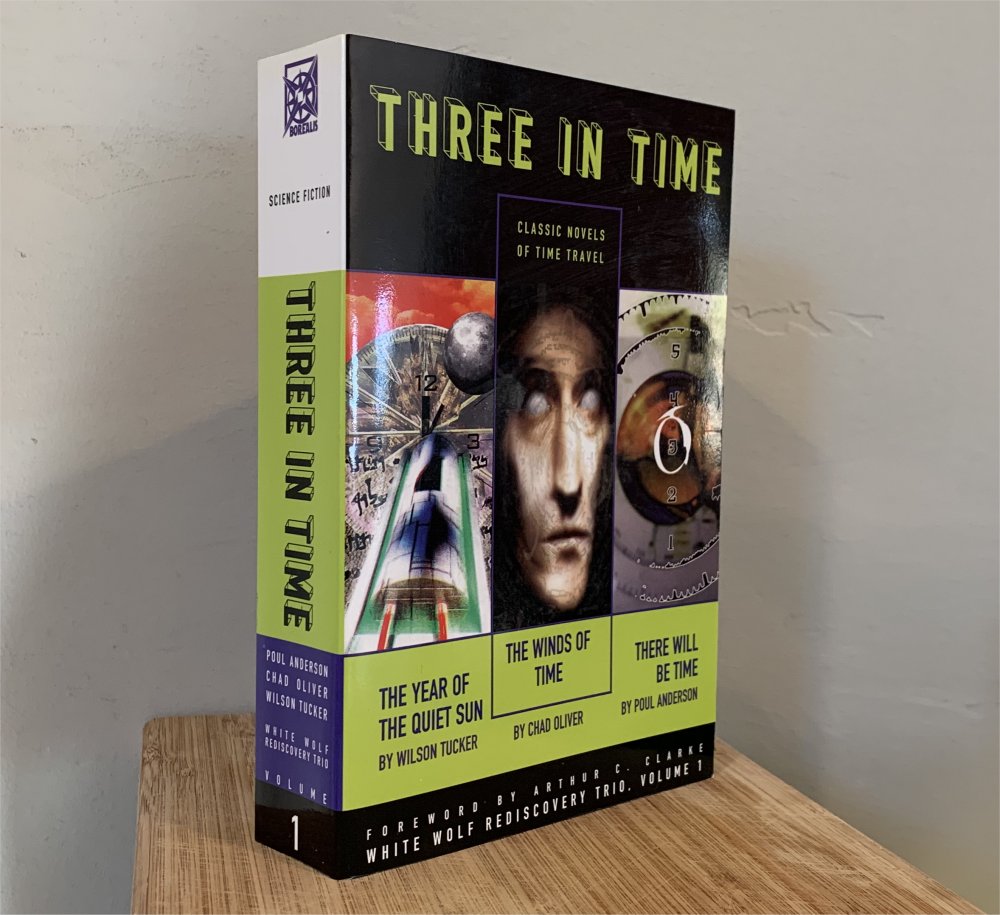The Fate of Intelligence: Chad Oliver’s The Winds of Time
The Winds of Time by Chad Oliver; First Edition: Doubleday, 1957.
Cover art Dick Shelton. (Click to enlarge)
The Winds of Time
by Chad Oliver
Doubleday (192 pages, $3.95, hardcover, April 1957)
Cover art Dick Shelton
This science fiction novel from 1957 is by an author known for anthropologically informed works (Wikipedia; SFE). He was an anthropologist himself, and thus one of the few science fiction writers who was also a scientist.
Oliver published nine novels from the early 1950s into the 1990s, not all of them SF. His work is currently in print only through several titles in the UK Gateway line and in three omnibus volumes from NESFA Press.
The present volume is currently available as a Gateway e-book (not listed on the SF Gateway page linked above), and in a 1997 omnibus of three “time travel” novels for White Wolf/Borealis, Three in Time, edited by Jack Dann, Pamela Sargent, and George Zebrowski, which is currently available on Amazon. I note this because generally I try to cover in these reviews only books that are readily available in some current, unused edition, and the last title serves to qualify this Oliver novel. (Though I broke this rule with my look back at Silverberg’s Collision Course a few months back.) In any event, I think it’s fair to say that Chad Oliver, while still remembered, isn’t remembered as among the Great SF Authors of all time, or even of the 1950s. Yet this novel is interesting nevertheless for its display of the standard SF furniture of the 1950s (as I discussed with Silverberg’s novel), and also for its anticipation of the quandary behind Fermi’s celebrated Paradox.
The Winds of Time by Chad Oliver; Avon Equinox, 1975.
Cover art Grey Morrow. (Click to enlarge)
All that said, the edition I read for this review is the 1975 Avon Equinox trade paperback, one of its SF Rediscovery series that ran some 27 volumes. Page references are from that edition.
Gist
A contemporary man vacationing in Colorado discovers a cave occupied by hibernating aliens. He learns the backstory of how they came to Earth, then helps them research the necessary technology so they can build a new spaceship and return to their home world. When this proves unsuccessful, the man joins the aliens to hibernate for further centuries in the hope that humanity’s technology will eventually be sufficiently developed.
Take
This is a decent SF novel of the 1950s that, while it presumes aliens are much like humans, is a fine first-contact novel that considers the fates of intelligent species in the galaxy.
Summary
- The novel opens as a contemporary man, Weston Chase, is caught in a storm in the Colorado mountains and stumbles into a cave occupied by an alien being, Arvon, who has hibernated in this cave, along with four associates, for thousands or millions of years.
- A huge chunk of the middle of the book is devoted to Arvon’s tale.
- (In a recurring plot crutch of SF novels of this era, the aliens quickly learn English, rather than human characters learning the alien language or pretending that some kind of translation device exists.)
- Arvon tells about his ship, the Good Hope, that traveled through “not-space” using a “distortion field,” from the planet Lortas, with a crew of nine. Their mission was to find other planets and other species they might connect with. Their own culture has peaked, and they need others to contact, to learn from and grow.
- But again and again, they’ve found only three types of natives on other planets: primitives in the Stone Age; pre-industrial, war-like cultures; or technological cultures that have blown themselves up.
- They describe having landed on a planet of Alpha Centauri, and finding only a dead city, blown over with sand.
- Their next try took them to Earth. But their field drive failed and their ship was stranded. And so they used their “sleeping technology” to wait thousands of years until, perhaps, a technological society might emerge on this planet, Earth, to help them return home.
- There are some vivid scenes depicting their encounter, in what is later called Asian, with local tribes, before the survivors’ retreat into a cave… (as illustrated on the cover of the Avon Equinox edition).
- And so in the present Weston Chase is faced with trying to help these aliens build a spaceship to return to their own planet, here in 1956 America. They head for Chase’s home in Los Angeles.
- Chase, still nominally a captive, is cooperative, but the surviving aliens quickly survey LA and decide their cause is hopeless; the technology doesn’t exist for them to build the spaceship they need.
- They release Wes, who returns to his home (after some months) to find his wife has given him up and taken up with another man.
- With nothing left of his old life, Wes gets an idea: using the aliens’ sleep serum, he convinces them all to go back into hibernation, himself included, and wait. He’s confidant Earth won’t blow itself up.
- And so thousands of years later they all awake, emerge from that cave, and see a gigantic spaceship passing overhead. They made it. Chase realizes he’s still young, and still has time to live a full life.
Three In Time: Classic Novels of Time Travel
edited by Jack Dann, Pamela Sargent & George Zebrowski; White Wolf/Borealis 1997.
Cover art uncredited. (Click to enlarge)
Comments, Notes, and Quotes
- The novel’s inclusion in the omnibus Three In Time begs the question of how this is a time travel novel. It’s about time travel only in the most passive sense: going into hibernation and moving into the future unconsciously, to awake and live out the rest of one’s life in a future one would otherwise never have experienced.
- And one might question in what way the novel displays Oliver’s anthropological interests. I suppose it does so in the broadest possible way: it’s about the fate of the entire human race, given the experience of the aliens who’ve found three types of planets that ever supported intelligent races, with many of them having destroyed themselves.
- George Zebrowski’s introduction to the novel in Three in Time notes its thematic connection to two later novels about human-alien contact: Unearthly Neighbors (1960) and The Shores of Another Sea (1971). The last title seems to have been the best received; it’s available from SF Gateway.
- William F. Nolan’s afterword in Three in Time recalls that the author was called “Big Chad,” and had lived in the LA area from 1953 to 1955, hanging out with Nolan, Charles Beaumont, and Richard Matheson, and in a letter described his early interest in how anthropology would be explored via science fiction.
- The whole problem of other cultures and of “contact” between different cultural systems had always fascinated me in science fiction. Therefore, I was already into the basics of anthropology. I took two courses in it during my freshman year, but I was drawn strongly to English, and took a lot of literature courses. Of course, I’d been sending out stories since the Ohio days. But my fiction sales were still a ways ahead of me.
- So the overriding concern here is about whether an advanced industrial society, like humans on Earth, will blow itself up or not. This was a grave concern especially in the 1950s, only a decade or so after Hiroshima, and though the Cold War has now passed, that concern hasn’t gone completely away. It’s an obvious answer to the Fermi Paradox—if planets and presumably life are so common, why haven’t we met, or at least heard from or seen evidence of, other intelligent species? Well maybe because they all blow themselves up, within a timescale that makes coexistence of intelligent species over billions of years unlikely. Indeed, some current thinkers aren’t sanguine about humanity’s future; Yuval Noah Harari, in Sapiens, thinks we might have only another 1000 years, and sooner than that if the effects of climate change curtails continued technological development by its survivors.
- As science fiction, this book is all too typical of the way aliens are depicted in most early science fiction, and in some varieties of “space opera” to this day. They act and sound just like humans. The play similar roles: captain, navigator, novelist, anthropologist, etc. Their ship has a library, and even a bar (!), on board. SF has only rarely tried to imagine truly alien beings, but the standard of aliens as just like humans except for funny clothes or facial features has become entrenched in popular culture via Star Trek and Star Wars. Indeed, reading some of these 1950s SF novels, as I’ve been for the past couple years, I’ve been startled to see how the clichés of that era inspired Trek and Wars in the ‘60s and ‘70s and have become unshakeable decades later.
- There’s a fascinating passage about the aliens’ reasoning about the plausibility of other intelligent races, which, despite the use of 1950s language referring to themselves and equivalent creatures as “men” and “human beings,” is nevertheless a pertinent argument. p48-9:
Man was not a rare animal in the universe, and it was the height of egotism to imagine that he was. All isolated peoples believe that they are the only human begins in the world, and when a planet thinks itself alone, before the ships go out into space, it is difficult for the people on that planet to conceive of other human beings elsewhere among the stars… It was not that man was foreordained, built in from the beginning. It was simply that the evolution of intelligence, of the ability to develop culturally, necessarily proceeding along the road of trial and error, change and modification. A culture-bearing animal had to be warm-blooded, for he needed the energy, he had to be big-brained, he had to have free hands and specialized feet. A manlike form was the mechanical answer to one trend of evolution, and if conditions permitted he came along sooner or later.
- There’s a clever line of reasoning, p74, about the wisdom of finding a cave to hide in. The aliens come down at first in Asia, but decide to hole up in what was then a mostly empty continent, in Colorado. “He pointed again to Europe. ‘One day, when ships get good enough, men with a fairly complex culture will cross this ocean here, or possibly the other one; it doesn’t matter. They’ll find a virtually untouched land, and they’ll take it from its original settlers. Then that area will boom, and that’s where you’ll want to be.’”
- There’s quite a bit of detail at the end about Los Angeles, covered with “a gray pall of fog, mist, smoke, and that special urban effluvium called smog” p127. Union Station, Hollywood Freeway, Sunset Boulevard, Beverly Glen, UCLA, Santa Monica. The opening of the story, p16, mentions Chase’s “home on Beverly Glen off Sunset” and his “Westwood office.” Oliver seems to have known LA, and the Colorado mountains, fairly well.
Chad Oliver’s other SF novels:
Mists of Dawn (Winston, 1952, cover by Alex Schomburg)
Shadows in the Sun (Ballantine, 1943, cover uncredited)
Unearthly Neighbors (Ballantine, 1960, cover uncredited)
The Shores of Another Sea (Signet 1971, cover by Pepper)
Giants in the Dust (Pyramid 1976, cover uncredited)
(Click to enlarge)
Conclusion
- This is a solid SF novel that displays the virtues and presumptions of 1950s SF, with a pertinent speculative issue concerning the fate of intelligent civilizations.
A previous version of this review appeared at Views from Crestmont Drive in June 2019.
Mark R. Kelly’s last review for us was of Leigh Brackett’s The Long Tomorrow. Mark wrote short fiction reviews for Locus Magazine from 1987 to 2001, and is the founder of the Locus Online website, for which he won a Hugo Award in 2002. He established the Science Fiction Awards Database at sfadb.com. He is a retired aerospace software engineer who lived for decades in Southern California before moving to the Bay Area in 2015. Find more of his thoughts at Views from Crestmont Drive, which has this index of Black Gate reviews posted so far.



